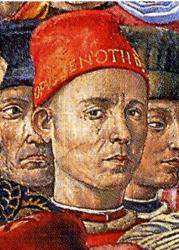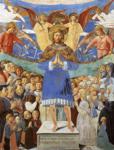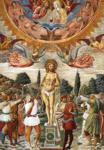Benozzo Gozzoli Biography

Benozzo Gozzoli was born in 1420 in Florence, the son of tailor Lese di Sandro.
Like many other painters of the early Renaissance, Gozzoli was initially trained as a goldsmith. At the age of 27 he began to work with Fra Angelico (1395-1455) in Orvieto and Rome. During his apprenticeship years, 1438-1444/45, in the workshop of Fra Angelico, Gozzoli took part in the decoration of the cells in the Dominican monastery of San Marco. The paintings in Cosimo de’Medici’s double cell (cell 38/39) are thought to have been done almost solely by him, and these include a depiction of the Adoration of the Magi.
After completing the work in San Marco, Benozzo entered into a contract with Lorenzo Ghiberti (1378-1455), to work with him for three years on the second Baptistery door in Florence, the Gate of Paradise, starting from 24 January 1445.
Both Fra Angelico and Lorenzo Ghiberti were to influence his entire work. From Ghiberti he learned precision in depicting the finest details and how to illustrate a story vividly, and from Fra Angelico, he took the latter’s bright color palette, which Gozzoli succeeded in transferring to the art of fresco painting.
After work with Ghiberti, Benozzo returned to Fra Angelico. They worked in Rome and Orvieto, where together with Fra Angelico he painted two of the four vault sections of the Chapel of San Brizio in the cathedral; Christ the Judge, Angels and the Chosen and the Choir of Prophets. The two vault sections that remained empty were completed 52 years later, by Luca Signorelli (ca 1445-1523) using sketches produced by Fra Angelico.
In 1449 Benozzo worked in Montefalco in Umbria where he left frescoes in the churches of San Fortunato and San Francesco. His first major independent commission was the fresco work in the choir of San Francesco in Montefalco with scenes from the life of St. Francis (1450-1452). The cycle of St. Francis in Montefalco contains a total of 17 episodes from the life and work of the saint, arranged in a total of 12 pictures and a lost stained glass window. In the vault, St. Frances is enthroned in glory with angels on either side; he is surrounded by the most important saints of the Franciscan order.
The commission to paint the private Medici Chapel brought the artist back to Florence. As early as 1442 Pope Martin V had given the Medicis permission to build a private chapel with a portable family altar. The chapel, on the first floor of the Medicis’ residence, was built by Michelozzo (1396-1472) between 1446 and 1449 and dedicated to the Holy Trinity. Stimulated by the prestige attached to this commission and the abundance of materials at his disposal (including gold), Gozzoli created one of the most fascinating fresco cycles of 15th-century Florence. Some art historians consider this to be his greatest work, and it is certainly the most famous of his works.
By 1463 at the latest, Benozzo had left his native city because of the danger of plague, and moved to San Gimignano, where he lived for four years, until 1467. There, in collaboration with several assistants, he did the second of his life’s two major works, the decoration of the apsidal chapel of the church of Sant’Agostino.
For the same church, Benozzo created a votive fresco showing St. Sebastian Intercessor on the southern nave wall. This is notable in that Benozzo went against iconographic canon, according to which St. Sebastian had to appear wearing a loincloth and pierced by arrows, instead depicting the saint fully clothed and unhurt. The saint is shown praying for the protection of the people surrounding him from the plague.
Benozzo painted another fresco with the same theme, the Martyrdom of St. Sebastian on the inner entrance wall of the collegiate church of Santa Maria Assunta in San Gimignano. On this occasion, the saint is depicted in accordance with the iconographic tradition of Italian art during the 15th century.
Benozzo spent the years 1464 and 1465 in Certaldo around San Gimignano. There he created a tabernacle that stood by to the bridge over the River Agliena. People condemned to death were led past it, which gave it the name “Tabernacle of the Condemned”. In 1958 the frescos were taken down and displayed in the chapel of San Tommaso in the Palazzo Pretorio in Certaldo. The theme of the pictures is the suffering of Christ and the martyrs.
Benozzo’s last creative period was in Pisa, where he was commissioned in 1469 to carry out a major cycle of frescos for the Composanto comprising 26 pictures from the Old Testament, on which he would work for 16 years. The frescos were almost entirely destroyed as a result of a bomb attack in 1944, which caused a great fire in the Composanto. The undamaged sections were taken off the walls. During the same creative period Benozzo stayed in Legoli in the province of Pisa, where he had fled in 1478/79 because of the plague. There he created a tabernacle, of which fragments remain today.
During this last creative period of his life, Benozzo also produced two oil paintings, making him one of the first Italian masters to work with oil. The works were the Descent from the Cross and the Raising of Lazarus, both painted for Bishop Pandolfini.
Benozzo Gozzoli died in 1497. He was buried in the monastery of San Domenico in Pistoria.
Bibliography
The Chapel of the Magi: Benozzo Gozzoli's Frescoes in the Palazzo Medici-Riccardi Florence by Benozzo, Cristina Acidini Luchinat. Thames & Hudson, 1994.
Benozzo Gozzoli by Diane Ahl. Yale University Press, 1996.
Gozzoli 1420-1497 (Masters of Italian Art) by Marion Opitz. Konemann, 1998.
Benozzo Gozzoli: Library of Great Painters (Library of Great Masters) by Luchinat. Scala Publishers, 1995.
- St. Sebastian Intercessor. Detail.

1464. Fresco, 523 x 248 cm. Nave of Apsidal Chapel of Sant' Agostino, San Gimignano, Italy.
- Martyrdom Of St. Sebastian.

1465. Fresco, 525 x 378 cm. Collegiata, Interior entrance wall, San Gimignano, Italy. Read Note.
- Tabernacle Of The Condemned.

1464-66. Frescos transferred to canvas. Palazzo Pretorio, Cappella san Tommaso, Certaldo, Italy.
- Descent From The Cross.

1491. Oil on canvas. 180 x 300 cm. Museo Horne, Florence, Italy. Read Note.
- Adoration Of The Magi.

1438-1444/45. Fresco. Cell 39. San Marco, Florence, Italy. Read Note.
- Madonna And Child Giving Blessings.

1449. Tempera on silk on a wooden mount. 254 x 130 cm. Santa Maria sopra Minerva, Rome, Italy.